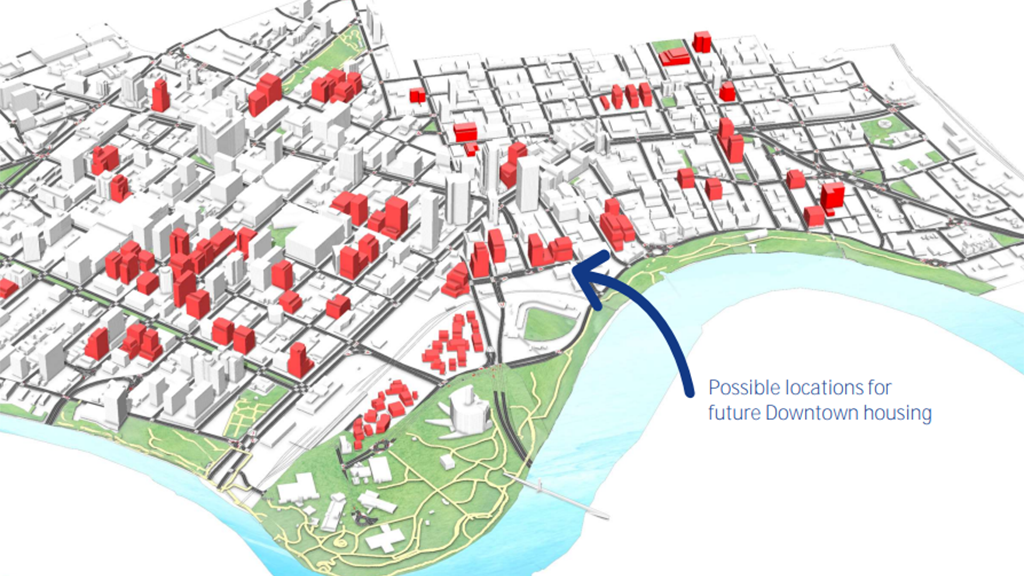The geographical centre of Canada is looking to densify and revitalize itself.
The City of Winnipeg is looking to change its downtown with CentrePlan 2050, a comprehensive rethink of the residential, transit and retail landscape.
“Downtown (Winnipeg) hasn’t had a long-range plan since the early 2000s, so it’s been almost a generation since we’ve had something that will guide us into the future,” City of Winnipeg planner Karin Kliewer said.
“We found it’s necessary to have a collection of actions and policies to figure out how to collaborate and work across city departments in order to build the downtown that we need to see in the future.”
Kliewer said Winnipeg’s downtown was already taking steps to revitalize before the COVID-19 pandemic took hold in 2020 but the pandemic exposed urban vulnerabilities not only in the city but across the world.
“In Winnipeg, one of our vulnerabilities was relying on the office population to bring life to downtown and that culture is changing. We realize we need more residents to live downtown,” she said.
“We tried to figure out through this plan how to attract more people to live and to visit downtown and to how to make life better for those who already live there.”
She said changing downtown to make it more livable involves building and street design standards increasing amenities in parks and “just making downtown a more amenable place to be.”
Kliewer said top of mind is ensuring a wide variety of income levels can live and work in the city’s downtown core.
“Those developing most recently are considering mixed incomes, not just one income range for buildings. It’s very important to capitalize on existing incentives from all three levels of government in order to get that mixed income because we absolutely don’t want to push anyone out, but we also want to attract additional people,” she said.
Winnipeg also has a large Indigenous population and Kliewer said the city will work with organizations already in place who know what their communities need.
“There’s an urban Indigenous community, Indigenous governments, Metis, Inuit and First Nations and everyone has high capacity and high motivation to create a difference. It does seem like a hopeful time,” she said.
One of the challenges of reshaping Winnipeg’s downtown is that “it’s geographically huge compared to other downtowns and it’s very different in character as you go across those geographies.
“You have development of The Forks, South Broadway, which is mostly low-rise, downtown proper by Portage and Main, which is highrise, and The Exchange which is a national historic site. The intention of CentrePlan is to capitalize on the unique character of each of these areas, play off it and enhance it,” Kliewer said.
The new Winnipeg Transit Master Plan passed last year is linked to ongoing CentrePlan development, she added, in that increasing transit efficiency and accessibility will drive further transit-oriented housing including the city’s downtown.
Winnipeg must also contend with some of the coldest weather in the country and Kliewer said the city has learned lessons from Edmonton in terms of winter design while working with harsh weather conditions.
“They’re cutting edge in this regard and being able to situate your buildings and which side of the street you want to focus amenities on, that will all hopefully be integrated into urban design guidelines. We have the (existing) Skywalk network and obviously want people walking on the streets as well but in the winter we know that we need both,” she said.
She added it may be cost-prohibitive to continue with the underground system currently in place at Portage and Main, the centre of both the city and of Canada, and also one of the country’s coldest locations.
“At-grade is definitely the direction we’ve been given. We’ve heard from the public asking ‘Can we have both?’ We don’t know the future of it but it is more cost-effective to decommission it,” she said.
While the plan cites 2050 as the end date, she added “there are priority actions that we need to be getting onto tomorrow.”
She cited redevelopment of Graham Avenue, which now exists as a pedestrian-only area with bus routes as a current area of focus. As the transit is re-routed, the city is taking input on how to change the avenue and add further public amenities.
“Once the buses come off there’s an opportunity to fill it with something else. We struggle with unsavory activity, and we want to fill the space with something positive and inclusive,” she said.
“If we can figure out how to animate during the winter, Graham Avenue would be more of a linear park and plaza.”
More information on CentrePlan 2050 is available here.



Recent Comments